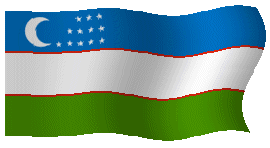
 Uzbekistan
(About - O'zbekiston) is located in the
central part of Central Asia, between two great rivers the
Amudarya and the Syrdarya. A combination of plains
and mountains characterizes the country landscape. The
plateau Ustyurt, the old bed of the river Amudarya, the Kyzylkum desert. Uzbek is
closely
related to other Central Asian languages, including Turkmen, Kazakh, and Uygur (which is spoken in western
China). Prior to 1922, Uzbek
was written in the Latin script.
Uzbekistan
(About - O'zbekiston) is located in the
central part of Central Asia, between two great rivers the
Amudarya and the Syrdarya. A combination of plains
and mountains characterizes the country landscape. The
plateau Ustyurt, the old bed of the river Amudarya, the Kyzylkum desert. Uzbek is
closely
related to other Central Asian languages, including Turkmen, Kazakh, and Uygur (which is spoken in western
China). Prior to 1922, Uzbek
was written in the Latin script. .png) The area of Uzbekistan is 172,700
square
miles (447,400 square kilometers). Uzbekistan is bordered
by Kazakhstan to the west and north, the Karakalpakstan Aral Sea to the
north, Tajikistan and Kyrgyzstan to the south and east,
and Turkmenistan and Afghanistan to the south. Uzbekistan
is blessed with two large rivers: the Amudarya (Oxus), and
the Syrdarya. About 40% of the country is within the
Kyzylkum Desert, an expanse of virtually uninhabitable
sand; only 10% of the land is arable, in the
heavily-cultivated river valleys. The highest point is
Adelunga Toghi in the Tian Shan mountains, at 14,111 feet
(4,301 meters)[1].
The area of Uzbekistan is 172,700
square
miles (447,400 square kilometers). Uzbekistan is bordered
by Kazakhstan to the west and north, the Karakalpakstan Aral Sea to the
north, Tajikistan and Kyrgyzstan to the south and east,
and Turkmenistan and Afghanistan to the south. Uzbekistan
is blessed with two large rivers: the Amudarya (Oxus), and
the Syrdarya. About 40% of the country is within the
Kyzylkum Desert, an expanse of virtually uninhabitable
sand; only 10% of the land is arable, in the
heavily-cultivated river valleys. The highest point is
Adelunga Toghi in the Tian Shan mountains, at 14,111 feet
(4,301 meters)[1].
History, Prominent Figures, Ancient cities
.gif)
The territory of modern-day Uzbekistan and its close neighbors have seen many empires rise and fall. The Sogdians, the Macedonians, the Huns, the Great Seljuk dynasty, the Mongolians, the Timurids and the Khanates of Samarkand, Bukhara Khiva and Khorezm all held sway here at one time or another. Central Asia really came of age with the development of the Silk Road from China to the West. Samarkand and Bukhara lay astride this, the most valuable trading route of its day [2]. The riches that it brought were used to build fabulous mosques and madrassars, most of which were destroyed by the Mongol hordes in the 13th century. Much of the damage was repaired and new cities were built by Amir Timur in the 14th century. Timur conquered all before him and, at its height, his empire stretched from Moscow and Baghdad and as far west as Ankara in Turkey. See more ...
|
Travel Guide for Tourists .gif)
Uzbekistan is the epitome of ancient Oriental mystery and beauty. Virtually every tour of Central Asia in general, involves visiting exciting historical sights and lovely environmental scenery. Here one can find influences of many oriental cultures, along with the tales of mystery and romance that are embodied here. There are so many must-see places in Uzbekistan. Since the area is so ancient, there are many amazing historical structures to visit, as well as a variety of museums housing fascinating archeological and anthropological finds. The architecture in particular is of such intensely profound beauty that words fail to adequately describe it. [3]. See more ...
Literature
.gif)
Uzbek literature developed on the base of rich folklore and oral traditions. Although its roots stretch as far back as the 9th century, modern Uzbek literature traces its origins in large part to Chagatai literature, a body of works written in the Turkic literary language of Chagatai.
Art, Culture and more .gif)
Hospitality is the essential part of Uzbekistan culture. People lived on the crossroads of the ancient Silk Road and their lives highly depended on the business they conducted with foreigners that traveled from east to west and back, carrying silk, pottery and other goods. Uzbekistan is well known for its chaikhanas (teahouses), where men get together and spend time chatting and joking over a cup of tea. It is part of the culture that women take care of the house, including cooking. The applied art of Uzbekistan is a real cultural and historical phenomenon. It is well known because of Uzbek traditions. The beautiful architectural ensembles of Bukhara, Samarkand, Khiva, Tashkent and Ferghana are famous for their pieces of applied arts. [4]. See more ...
Uzbek National Cuisine .gif)
Uzbek cuisine is influenced by local agriculture, as in most nations. There is a great deal of grain farming in Uzbekistan, so breads and noodles are of importance and Uzbek cuisine has been characterized as "noodle-rich". Uzbek dishes differ in appearance, fragrance and flavor. Some of them are prepared on the everyday basis, others are seasonal, some are cooked more rarely, depending on the seasonal availability of ingredients or to celebrate certain special occasions.
Tools (Asboblar), Local Stuff
.gif)
Media - Broadcasting, Music, Newspapers .gif)
The rich variety of Uzbek musical instruments reflects the diversity of musical styles performed on them. Small ensembles of mixed instruments are at the heart of the classical maqom tradition. Characteristic instruments in such ensembles include long-necked fretted lutes (tanbur, dutar, tar, rubab, sato), spike fiddle (ghijak), side-blown flute (nay), struck zither (chang), frame drum (dayra) and a small clarinetlike instrument made from reed (qoshnay). Another typical ensemble consists of long trumpets (karnai), loud oboes (surnai) and, sometimes, kettledrums (naghora), which are an obligatory presence at festive and ceremonial occasions. In rural regions, epic singers accompany themselves on a short fretless lute (dombra), while amateur musicians may play the Uzbek's harp (chang-kobuz) or a simple variety of spike fiddle (kiak).
References
- 1. orexca.com
- 2. uzbekistan
- 3. east-site
- 4. advan-tour
- 5. List of Scientists
- 6. Uzbek literature
- 7. Uzbek people